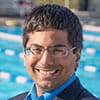USMS Grant Program Helps Clubs Get Through Coronavirus Pandemic
The USMS COVID-19 Relief Program granted more than $170,000 to 110 clubs serving nearly 9,000 members
John Carroll didn’t know what was going to happen to his workout group last year.
Like Masters programs across the country, Central Illinois Masters lost access to its pool in mid-March because of the coronavirus pandemic. Carroll worried that he would lose many of the new swimmers he had worked so hard to add over the years.
So began the coach’s scramble to find available water.
Starting in late May, he rented a small lake in which he set up an approximately 200-yard course that 10 swimmers could use at once. He then found a pool his swimmers could use over the summer in a nearby community, though on one condition: Because the pool was struggling to find lifeguards, Central Illinois Masters would have to use members as lifeguards.
Carroll’s struggles slowed toward the end of 2020 when his workout group was allowed back into its pool and received matching grants through the USMS COVID-19 Relief Program for Clubs from U.S. Masters Swimming and its LMSC, the Illinois LMSC. The funding allowed him to rent more lane space, giving his swimmers more opportunities to swim because social distancing restrictions limited how many could swim at once.
Central Illinois Masters was one of 110 Masters programs that received funding through the grant program. Those clubs serve nearly 9,000 members and received more than $170,000 to help them get through the pandemic and begin their process of rebuilding and growing.
Marcia’s Enthusiastic Masters of Oakland Coach Marcia Benjamin experienced many of the same struggles as Carroll and other Masters coaches across the country. Her club lost access to its pool in March and didn’t have a place to swim for more than 200 days.
When her county began allowing organized groups to swim last fall, Benjamin’s schedule filled up. Her club wasn’t allowed to return to its previous pool, so she started looking throughout her county for places to swim. The high school pool she found had a few problems. She needed to buy clocks because the pool had none and a speaker system because she wasn’t allowed to walk to the other end of the pool to coach swimmers there. She used grant funding to pay for it all.
MEMO now has 145 members, just one fewer than it had in 2020.
“That’s pretty amazing because my team is all about competition,” Benjamin says. “I make everyone go to our Pacific LMSC championships. I get 50 people in the month before championships. We haven’t had a swim meet since February 2020. Having this number of people without even having a championship is a really big deal for us.”
The grant funding helped North Carolina Aquatic Club Masters – Chapel Hill take a step that the workout group hadn’t been able to before: hire a coach. They hired Justin Wright, a former U.S. National Team member who holds the University of Arizona’s school record in the 200 butterfly.
The workout group has grown quickly this year. It had five swimmers in mid-February, now has about 15, and is receiving multiple emails each week from interested swimmers.
“[The grant] was just a great incentive for us,” NCAM member Keri Cleary says. “It was like, ‘We have the grant. Let’s get started. Let’s hire our coach. Let’s get these swimmers back in the water as quickly as possible.’ I truthfully expect that we’ll be at 30 swimmers in no time, which will be great for us.”
But the benefits of the funding extend beyond just financial assistance in a difficult year for coaches and Masters programs, says Carroll, the Central Illinois Masters coach whose group has rebounded to 74 members.
“We sometimes kind of feel like we’re on our own,” Carroll says. “The grant helped me feel like, ‘Wow, somebody cares that we do keep going.’ Sometimes that’s all it takes, a little shot, a little bit of encouragement will keep us going a long time, to sort of recognize that you guys are important and we want you to keep trying and keep going.”
Categories:
- About USMS
SIGN UP FOR UPDATES FROM USMS
















